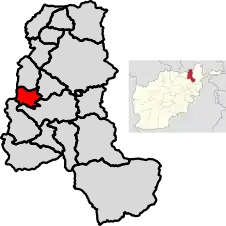Baharak District | |
|---|---|
 Location of the district in Takhar Province | |
| Coordinates: 36°48′18″N 69°24′36″E / 36.805°N 69.41°E | |
| Country | |
| Province | Takhār Province |
| Established | 1992[1] |
| Functioning | 2002 |
| Area | |
| • District | 231 km2 (89 sq mi) |
| Elevation | 703 m (2,306 ft) |
| Population (2019)[4] | |
| • District | 34,339 |
| • Density | 149/km2 (390/sq mi) |
| • Urban | 0 |
| • Rural | 34,339 |
| Ethnicity | |
| • Uzbek | 83% |
| • Pashtun | 10% |
| • Tajik | 5% |
| • Hazara | 2% |
| Time zone | UTC+4:30 (Afghanistan Standard Time) |
| Post code | 3762[5] |
Baharak District is a district of Takhar Province, Afghanistan. The district was split-off from Taluqan District in 2005.[6] Most people work in agriculture. The district has been the site of fighting between the Afghan Government and the Taliban; Baharak was considered to be contested in late 2018 and taken by the Taliban by August 2021.[7][8]
Geography

Baharak has an area of 231 square kilometers, comparatively equivalent to the area of São Vicente.[9] There are secondary roads that connect the district to the provincial capital, Taloqan, and a smaller road connecting the district with Khwaja Ghar District. It is 15 kilometers away from Taloqan.[3]
Baharak is bordered by Khwaja Ghar District to the north, Hazar Sumuch District to the east, Taluqan District to the south, and Bangi District with Dashti Archi District to the west. Dashti Archi is located in Kunduz Province, with all other districts located in Takhar Province.[10] Baharak may also border Aqtash District,[11] but Aqtash is a temporary district.[4]
There is another Baharak District in Badakhshan Province.
Demographics
Baharak has a population of 34339 and a sex ratio of 101 males for every 100 females. Most of the district is made up of Uzbeks, with Pashtun, Tajik, and Hazara minorities.[1] The median age is 16.6 and 57.6% of the population is unemployed. 13% of the unemployed are seeking work. Baharak has about 4800 households, with an average size of 7.1 people.[12]
Economy
Close to half of employed people in Baharak work in agriculture, forestry, or fishing.[12] Wheat and rice are the main crops, with barley, sorghum, sesame, corn, cotton, and melon also being grown.[3] However, there is a lack of seeds, machinery, cold storages, and fertilizer.[2] There used to be livestock, but much was lost because of war and drought.[1]
Handicraft is another trade present in Baharak.[2]
Education and healthcare
Baharak has a 35% literacy rate among people ages 15–24.[12] There is one madrasa, two high schools, and several primary schools in the district. The education situation has been improving- in 2002 there were only a handful of schools.[1] However, there is a lack of teachers, supplies, and anti-government opposition to schools.
There are two health centers in Baharak: one by the district center and another by the village of Qara Kamar.[10] There is also an ambulance to transport patients to Taloqan if needed. Tuberculosis and malaria remain an issue.[1][3] Baharak suffers from a lack of medical knowledge, money, doctors, and medical equipment.[2]
References
- 1 2 3 4 5 6 "District Profile: Baharak" (PDF). mrrd-nabdp.org. 12 September 2002. Archived from the original (PDF) on 18 July 2014. Retrieved 12 August 2020.
- 1 2 3 4 "Baharak District Development Plan" (PDF). mrrd-nabdp.org. 2006. Archived from the original (PDF) on 3 March 2016. Retrieved 12 August 2020.
- 1 2 3 4 "Baharak District". takhar.gov.af. Retrieved 14 August 2020.
- 1 2 "Estimated Population of Afghanistan 2019-20" (PDF). nsia.gov.af. 2019. p. 29. Archived from the original (PDF) on 9 June 2020. Retrieved 12 August 2020.
- ↑ "Baharak Post Codes". worldpostalcode.com. Retrieved 12 August 2020.
- ↑ "398 District Division Matching to 329 District Division". aims.org. Archived from the original on 22 March 2016. Retrieved 14 August 2020.
- ↑ "Quarterly Report to the United States Congress" (PDF). SIGAR. 30 January 2019. p. 71. Retrieved 14 August 2020.
- ↑ "Mapping the advance of the Taliban in Afghanistan". BBC News. 5 August 2021. Retrieved 5 August 2021.
- ↑ "Islands by Land Area". unep.ch. 1998. Archived from the original on 1 December 2015. Retrieved 13 August 2020.
- 1 2 "Takhar Province Reference Map". humanitarianresponse.info. United Nations Office for the Coordination of Humanitarian Affairs. 9 February 2014. Retrieved 13 August 2020.
- ↑ "Afghanistan District Maps". www.arcgis.com. Retrieved 5 October 2020.
- 1 2 3 UNFPA (5 January 2015). "Takhar Socio-economic and Demographics Survey". unfpa.org. Retrieved 14 August 2020.
External links
- Practice voting exercise in Baharak District, 2009
